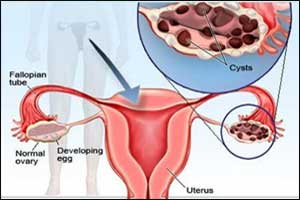- Home
- Editorial
- News
- Practice Guidelines
- Anesthesiology Guidelines
- Cancer Guidelines
- Cardiac Sciences Guidelines
- Critical Care Guidelines
- Dentistry Guidelines
- Dermatology Guidelines
- Diabetes and Endo Guidelines
- Diagnostics Guidelines
- ENT Guidelines
- Featured Practice Guidelines
- Gastroenterology Guidelines
- Geriatrics Guidelines
- Medicine Guidelines
- Nephrology Guidelines
- Neurosciences Guidelines
- Obs and Gynae Guidelines
- Ophthalmology Guidelines
- Orthopaedics Guidelines
- Paediatrics Guidelines
- Psychiatry Guidelines
- Pulmonology Guidelines
- Radiology Guidelines
- Surgery Guidelines
- Urology Guidelines
Simple Ovarian Cysts on Ultrasound Need No Further Monitoring

A new study published in the JAMA Internal Medicine reports that simple cysts are not associated with an increased risk of ovarian cancer, whereas complex cysts or solid masses are associated with a significantly increased risk of ovarian cancer.
Rebecca Smith and associates conducted a nested case-control study of patients to quantify the risk of ovarian cancer based on ultrasonographic characteristics of ovarian masses, including simple cysts, in a large unselected population.
Read Also: Statins lower ovarian cancer risk in women over 50
The study included 72 093 women who underwent pelvic ultrasonography. the primary outcome was the identification of malignant ovarian cancer. The study found that among 210 women who were diagnosed as having ovarian cancer, 49 were younger than 50 years, and 161 were 50 years or older.
The key study findings included are:
- Ultrasonography findings were predictive of cancer (C statistic, 0.89).
- The risk of cancer was significantly elevated in women with complex cysts or solid masses, with likelihood ratios relative to women with normal ovaries ranging from 8 to 74 and the 3-year risk of cancer ranging from 9 to 430 cases per 1000 women based on patient age and ultrasonography findings.
- In contrast, the 23.8% of women younger than 50 years and the 13.4% of women 50 years or older with simple cysts were not at a significantly increased risk of ovarian cancer compared with women with normal ovaries.
- Likelihood ratios associated with the detection of a simple cyst were 0.00 in women younger than 50 years (no cancers were identified) and 0.10 in women 50 years or older, and the absolute 3-year risk of cancer ranged from 0 to 0.5 cases per 1000 women.
Read Also: New combination of drugs for treatment of ovarian cancer
“We used to take them out, so we're doing better than we used to — but they don't turn into cancer. This is not what cancer looks like, and it has just become an area where we are doing unnecessary imaging without any benefit," Smith-Bindman said.
The study concluded that the ultrasonographic appearance of ovarian masses is strongly associated with a woman’s risk of ovarian cancer but simple cysts are benign and not associated with an increased risk of ovarian cancer, whereas complex cysts or solid masses are associated with an increased risk of ovarian cancer.
For full information log on to3 10.1001/jamainternmed.2018.511

Disclaimer: This site is primarily intended for healthcare professionals. Any content/information on this website does not replace the advice of medical and/or health professionals and should not be construed as medical/diagnostic advice/endorsement or prescription. Use of this site is subject to our terms of use, privacy policy, advertisement policy. © 2020 Minerva Medical Treatment Pvt Ltd